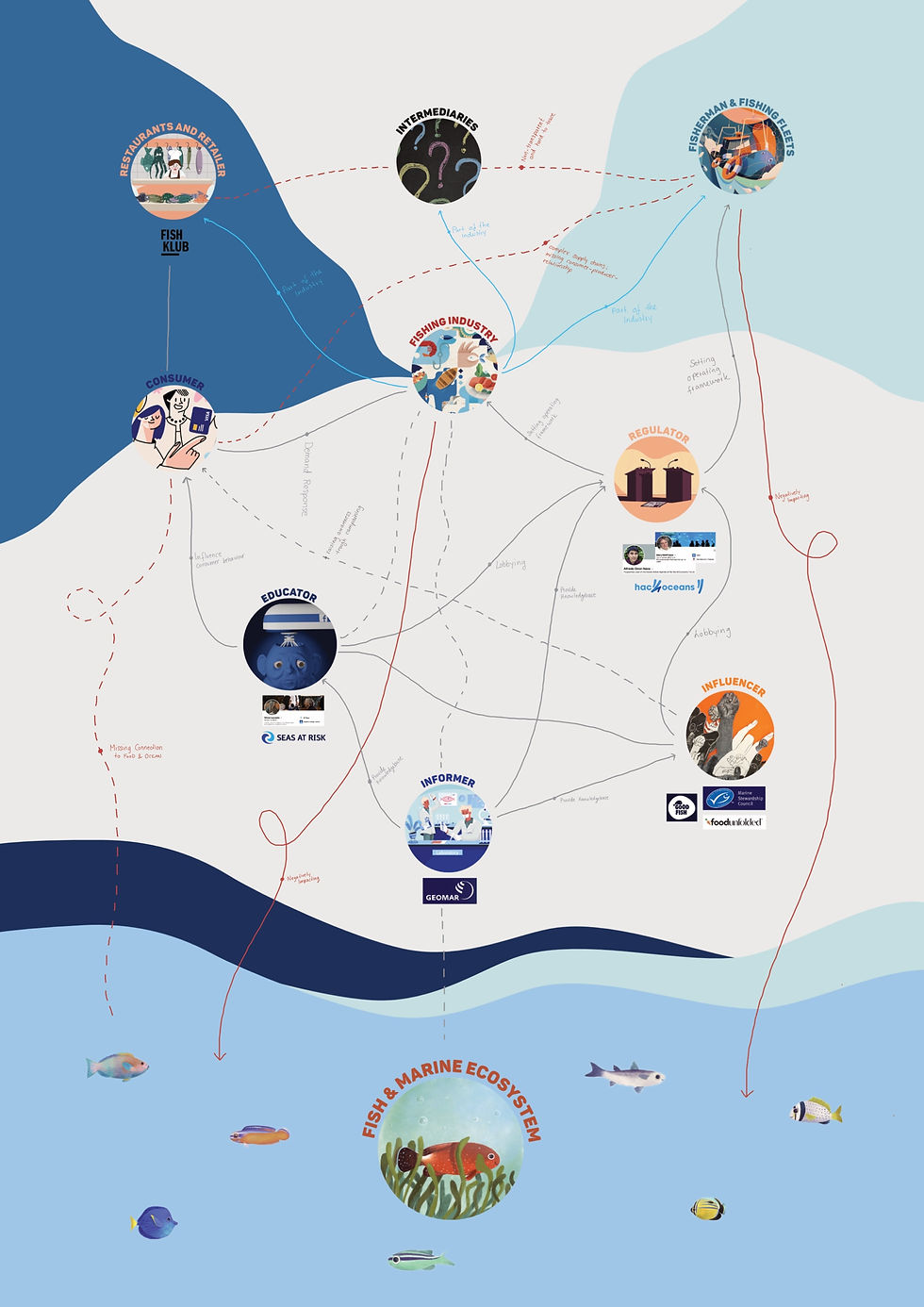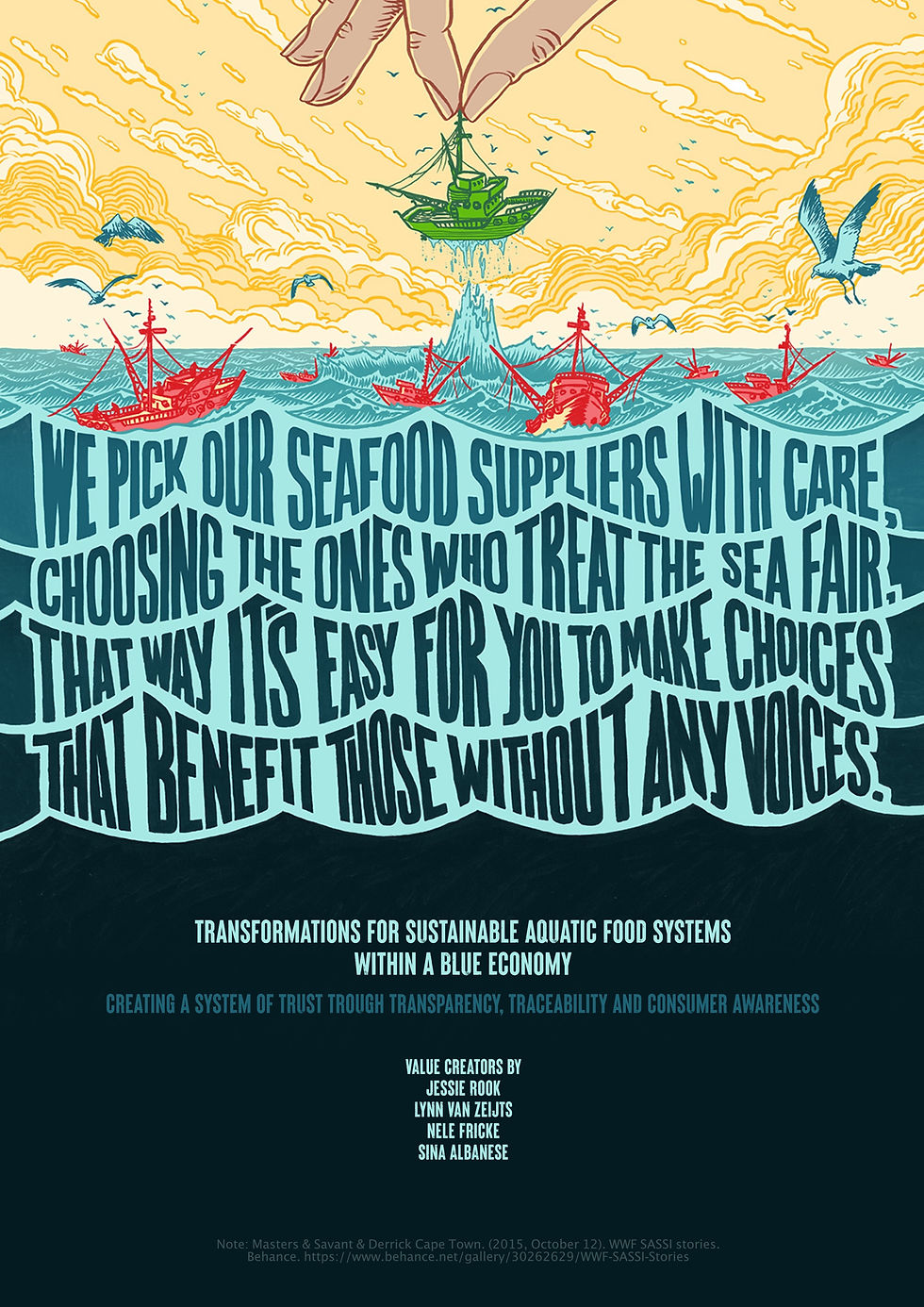Vote with Your Fork: Making a difference in our aquatic food system
- info-valuecreators
- Feb 15, 2023
- 5 min read
We are using resources as if we had two planets, not one. But there can be no 'plan B' because there is no 'planet B'. – Ban Ki-moon

At the very beginning of this journey, we asked ourselves the question, what is if we would face completely fishless oceans? The underlying cause: the extinction of species as a consequence of habitat loss, overfishing, pollution and climate change. The rising demand for seafood makes it attractive for industrial fishing companies to fish in giant amounts, applying destructive fishing methods. Whereas this might lead to financial profit for large industrial fishing companies, these methods could be considered as a huge loss when seeing it from a broader, ecological or equity perspective. The repercussions are unimaginable when one considers that over two-thirds of the planet's surface is made up of oceans, seas, and coastal regions, which are also an integral and crucial part of the planet's ecosystem and provide a living for over three billion people. Further, oceans are essential for human health and global food security while also being the main controller of the global climate, a significant sink for greenhouse gases, and the source of our oxygen and water. In other words, we must exercise greater caution in how we use, interact with, and extract resources from the ocean. Coming from that, we committed our semester to this topic, namely transformations for sustainable aquatic food systems within the blue economy to contribute towards turning the tide within the industrial fishing industry.
Finding our place within the complexity of this system

The global aquatic food system consists of a complex web including all the elements and activities that relate to foods from water, along with parts of the broader economic, social and natural environments in which they are embedded.
It encompasses all steps from production to consumption, as well as outcomes related to nutrition, public health, food security, social and economic prosperity, and environmental sustainability. To gain a comprehensive understanding of ocean processes, dynamics, and interdependencies, as well as human interactions, we reached out to a wide range of stakeholders and participated in related events. Like this, we build our own network consisting of stakeholders such as end consumer, fishers like Hendrik Kramer and their cooperatives such as the Dutch Vissersbond, as well as NGOs and researchers like Canadian OceanWise, GEOMA Kiel, US/Mexican Gulf of California Marine program, the Dutch organization Visikhetmaar, and many more. This not only helped us in making sense of the dynamics, but also helped explore actions to drive sustainable (aquatic) food system solutions, helping us define our place in the system and to pinpoint the key components of our value-adding product. Some of us also got the opportunity to participate at the Hack4Ocean youth innovation event in Brussels, which was another great opportunity to expand the network, meet and exchange with participants from across Europe, and together learn, explore and co-create opportunities for the sustainable use of marine resources. The workshops, the conducted interviews, and the free-choice activities further provided enormous support for the Value Creator's overall journey. While in earlier stages activities were more helpful in breaking down the broad topic and identifying systemic gaps that require attention and work, in later stages activities directly influenced the shape of our final value product.
To keep it simple and brief, all of these interactions made us understand that the fastest and most long-lasting driver for sustainability was found to be the end consumers as they drive the demand which most influences the supply and therefore the fishing industry. Also, a demand shift towards more sustainable seafood could work as an important incentive for fishers to shift towards more sustainable fishing. Lack of knowledge and understanding of consumers was seen as the key barrier to sustainable purchasing behavior. It was found that there are still a lot of misconception about fish consumption. Awareness campaigns or documentaries such as Seaspiracy were a good start to put the industry into the spotlight but were often misleading to the perception that one only has the option to either don’t give a fu*k or stop eating fish at all. This lack of knowing about alternatives can be linked to the insufficient information provision due to little compliance with European labeling legislation in commercial fish stores. Creating a system of trust trough transparency, traceability, and consumer awareness was thus defined as being at the heart of our value adding product.
A local approach to a global challenge
Daily actions that may seem small in the first place can have a big impact, which is also clarified by the well-known statement to vote with your fork! With this as a guiding principle, the initial idea was to make use of the power of public visibility and awareness campaigns to raise consumer awareness about problems within the fishing industry but also on what, where, and how the seafood we consume is sourced, distributed, and processed. Additionally, we wanted to empower the consumers in their sustainable purchasing decision-making by providing them with alternatives and guidance toward more sustainable choices. However, once we started to make more concrete plans for the awareness campaign, we realized that there is a lack of sustainable seafood choices in the supermarkets. Dutch seafood consumers tend to eat mostly salmon, tuna, and cod. Consequently, the supermarkets mostly provide those fish species which makes it hard for the consumer to choose another, more sustainable seafood species. Even though the initial idea turned out to be different in the end, our final product is way more exiting, we think, and still covers all aspects we aimed to address with the awareness campaign.
With the understanding that a demand shift towards more sustainable seafood choices would drive most significantly toward a sustainable transformation of the entire seafood industry but especially regarding industrial fishing practices, Good Fish, created the “Viswijzer”, a both physical and online labeling system that shows consumers how sustainable a certain seafood species is through simple color coding. The final value product is the implementation of the Viswijzer labeling system using Visscher Seafood, a local fish shop in Zwolle, as the initial concept location for a more mainstream fish shop not specialized on sustainability. The product meets the end consumer at the critical intersection with the fishing industry, as the change of purchasing behavior of the end consumer was seen as a critical driver toward a sustainable transformation of the fishing industry as a whole. Visualizing to the end consumer what the most sustainable seafood choice is based on scientific data in an understandable manner by the fishmonger lowers barriers towards sustainable consumer purchasing behavior. In short, the final value product is a co-creation between different players of the fishing industry including fishers, fishmongers, non-profits, academia, government, and media. It empowers the consumer in informed decision-making, guiding them towards more sustainable choices as we understood that:

“The wonderful thing about food is you get three votes a day. Every one of them has the potential to change the world.” – Michael Pollman
Also, promoting transparency and traceability by putting this labeling system in place helps to create a more dependable system. Finally, it would be wonderful to see more fish stores adapting this labeling system so that one day they may be able to say:
“We pick our seafood supplier with care. Choosing the ones who treat the sea fair, that way it’s easy for you to make choices that benefit those without any voices.” - WWF SASSI Stories
Take a look at our Value Creator at Visscher Seafood in Zwolle. Maybe it even guides you to a more sustainable choice!
Also, if you like to know more about this journey or want to get involved, feel free to reach out!
Lynn van Zeijts
lynn.van.zeijts@windesheim.nl
Jessie Rook
jessie.rook@windesheim.nl
Sina Albanese
sina.albanese@windesheim.nl
Nele Fricke
nele.fricke@windesheim.nl






Comments